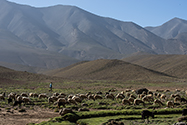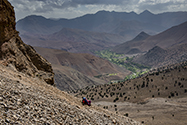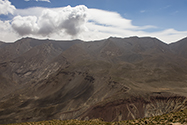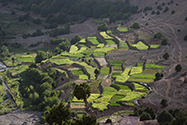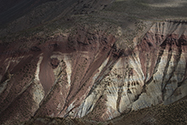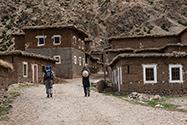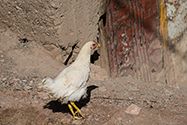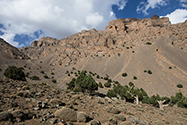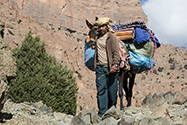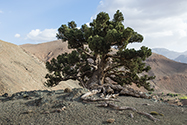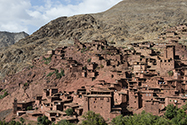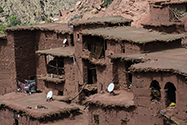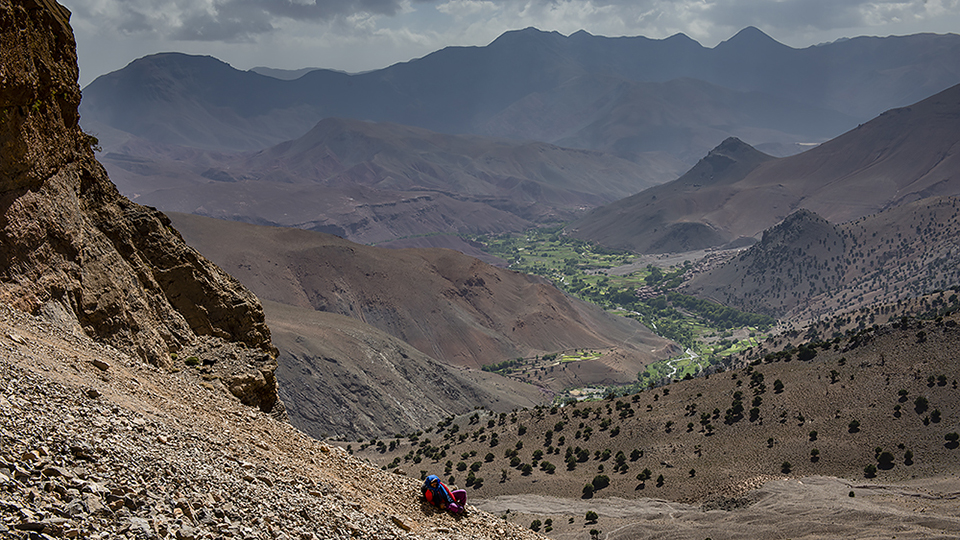
Majestic mountains, green valleys and an amazing clay village in M’Goun
The M’Goun area is an extraordinary mix of wild mountain landscapes, beautiful valleys and traditional villages. We walk over high passes with majestic views and (optionally) climb the M’Goun summit, one of the highest mountains in Morocco at 4 068 meters. This trek also takes us through wide and stunningly beautiful valleys with terraced fields and remote Berber villages. One of the highlights of the trek is the old village of Mgdez, a true gem with amazing ochre coloured, multi-storey clay and stone houses.
THE TOUR DAY BY DAY
Day one: Marrakech – Arous – Azib Ikkis (3 – 3,5 trekking hours)
The drive from Marrakech to Arous, the starting point for our trek, takes about 5 hours. Leaving the flat country behind us as we turn south on winding roads through the beautiful Aït Bouguemez valley, the mountains rise higher and higher. From a distance we can discern the M’Goun massif. Our trekking team, with mule drivers and cook, is waiting for us close to the Arous valley.
We start walking along a small gravel road that takes us into the valley and soon we enter the Arous village at 1 825 meters. In the surrounding fields the villagers grow apples, walnuts, barley, potatoes, corn and other vegetables. Beyond the village the wide and beautiful valley opens up, framed by red and rose-coloured mountains dotted with low bushes.
We walk slightly uphill to the guest house near Azib Ikkis (2 234 m) where we spend our first night. Here the Berber people take their goats, sheep and cows to graze in the summertime. Those who choose to spend the night camping continue a short distance beyond the guest house.
Day two: Azib Ikkis – Tarkeddit (6 – 7 trekking hours)
Today we start heading west into the Tinrmatin valley. We walk along a small path which zigzags steeper and steeper uphill beneath a beautifully sharp and rugged peak. The path temporarily levels out, and then ascends steeply before we reach the Tizi n’Ouri Pass at 3 400 meters. Up here panoramic vistas over the majestic M’Goun massif open up.
After a well-deserved break we descend about 500 meters towards the beautiful and wide Tarkeddit Plateau. On the spot where the plateau drops into the valley we are captivated by the sharply chiselled escarpments with their fascinating colours and forms. When we arrive at the small guest house and the camping site at 2 900 meters, we are right in the heart of the M’Goun area.
Day three: Tarkeddit – M’Goun summit – Tarkeddit (8,5 – 9 trekking hours)
It is still dark when we set off towards the M’Goun summit at 5 o’clock in the morning. Today we have a long and demanding climb ahead of us, requiring a lot of stamina. However, the ascent contains no technical difficulties and climbing experience is not needed to reach the top.
We walk across the plateau to the starting point for our climb. A small path takes us zigzagging up the not too steep mountain side, and as we reach the mountain crest great new views come into sight. We continue along the broad and barren ridge all the way to the top, the colours of the mountain shifting in varying shades of grey. After about 5 hours we reach the cairn that marks the summit of the M’Goun massif at 4 068 meters.
Here at the top, we are treated to breathtaking views over the surrounding landscape. To the south we can see the Valley of the Roses, famous for its rose gardens, and in clear weather we can even see as far as the semi-desert of Saghro. After a well-deserved rest we retrace our steps and begin the descent down to the Tarkeddit Plateau where we spend a second night.
For those not interested in climbing the summit alternatives are available. Please contact Jebel Trekking for arranging another program.
Day four: Tarkeddit – Amezri (6,5 – 7 trekking hours)
Today’s walk is quite demanding, but extraordinary beautiful and varied. We start heading west along a small stream meandering through the grass covered and wide Tarkeddit Plateau. Goats and sheep often graze here, looked after by their shepherds. At the far end of the plateau we gaze into the entrance of the wild and inaccessible Wandras ravine.
We continue slightly uphill and after a while we enter a barren stone landscape with rugged and peculiar boulders and rocks. We pass a nomad family settlement with animal grazing grounds, used in the summertime. Our trek takes us further across a stony plateau dotted with low bushes and further on we reach the Asdrem Pass at 3 200 meters. Here a spectacular landscape opens up and we are rewarded with breathtaking views over the Tessaout valley. The villages and the emerald green fields in the valley are embraced by reddish-brown mountains.
We descend into the Tessaout valley on a small dirt path, which zigzags steeply downhill and then traverses beneath steep and impressive mountain sides. After another steep passage downhill the path levels out and we walk through an area with beautiful scattered Juniper trees.
A long descent takes us down into the valley, where we pass several villages and terraced fields along a winding river. Further on we walk through the small village Tasgaywalt, before reaching the village Amezri (2 260 m) where we stay in the local guest house. Those who choose to spend the night camping continue and stay a short distance beyond Tasgaywalt.
Day five: Amezri – Aït Ali n’Itou (approx. 6 trekking hours)
This day offers nice and easy walking through a landscape very different from what we experienced yesterday. All day we walk slightly downhill along the winding river in the beautiful Tessaout valley. We leave Amezri behind on a path which takes us through the corn fields near the village. After a while we leave the path and continue a few kilometres along a sparsely trafficked road where mighty, rose coloured mountains rise steeply on both sides. The beauty of the scenery makes us forget that for a while we have asphalt beneath our hiking boots.
We pass Ichebakan, a village overlooking the river, where the houses cling to the mountain slope. Our walk continues along a small gravel road following the course of the river, which we cross a few times, not always dry-shod. In places we walk through sparse poplar forest with rugged mountains in different shades of rose rising above us.
When we get closer to the village Aït Hamza, we walk through groves of walnut trees and fruit farms with apples, pears and peaches. In harvest time the villagers generously offer us a taste. Our trek ends in Aït Ali n’Itou (1 800 m) where we spend our last night in the village guest house, or alternatively camp nearby the river.
Day six: Aït Ali n’Itou – Mgdez – Marrakech
Before turning back to Marrakech, we make a short car trip to the stunning old village of Mgdez, situated at 1 939 meters, and generally regarded as one of the most beautiful villages throughout the Atlas Mountains.
Amazing ochre coloured clay houses and stone houses with flat thatched roofs climb up a steep mountain side, as if they were piled on top of each other. Between the houses, which almost merge into the rock, narrow steep alleys run, inaccessible for vehicles. Many of the houses are multi-storey buildings, some of them more than 400 years old. When we stroll about in the village, we pass small courtyards where the villagers keep their cows, chickens and goats, and in harvest time walnuts are drying on the roofs. If we are lucky, we may be invited for a glass of traditional mint tea in a local family house.
After the visit in this fascinating and extraordinary village we begin our trip back to Marrakech, where we will arrive about 4,5 – 5 hours later.

